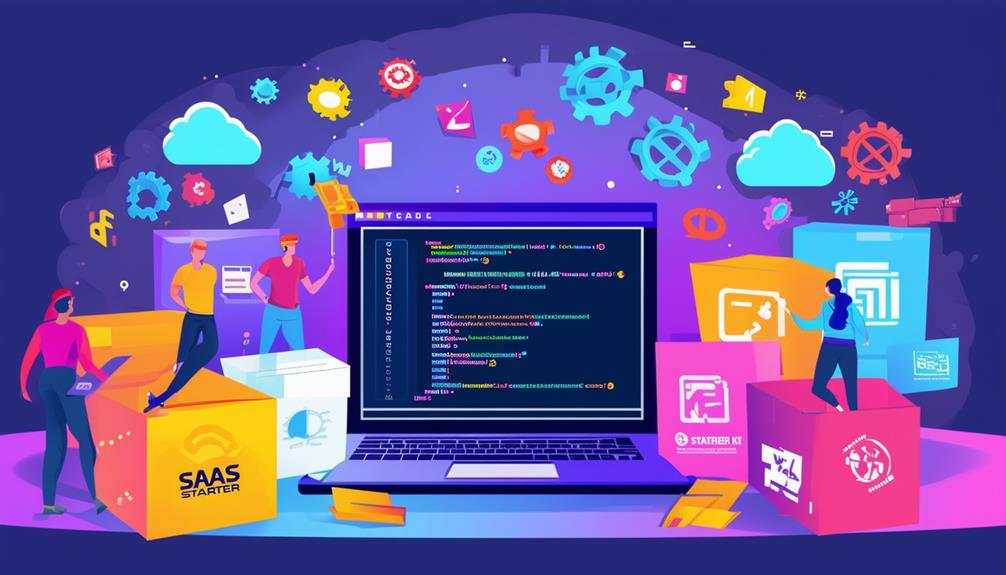When you’re developing a SaaS application, you’re likely facing tight deadlines and resource constraints. That’s where SaaS boilerplates come in. These pre-built templates can slash your initial development time by up to 40%, allowing you to focus on your unique value proposition rather than reinventing the wheel. By incorporating industry best practices for security, scalability, and maintainability, boilerplates provide a solid foundation for your project. They’re not just about saving time; they’re about improving quality and consistency across your development process. But how do you choose the right boilerplate, and what are the potential pitfalls?
Understanding SaaS Boilerplates
SaaS boilerplates are pre-built code templates that provide a foundation for rapidly developing and deploying software-as-a-service applications. These templates typically include essential components and configurations commonly used in SaaS projects, such as user authentication, database integration, and basic UI elements. By leveraging boilerplates, you can markedly reduce development time and guarantee consistent, best-practice implementations across your projects.
When selecting a SaaS boilerplate, consider your specific tech stack requirements. Popular options include MERN (MongoDB, Express, React, Node.js) and MEAN (MongoDB, Express, Angular, Node.js) stacks. Each boilerplate offers different features and optimizations, so evaluate them based on your project’s needs.
To maximize the benefits of SaaS boilerplates:
- Customize the template to fit your unique requirements.
- Regularly update the boilerplate components to maintain security and performance.
- Document any modifications for easier maintenance and onboarding.
Benefits of Using Boilerplates
By leveraging boilerplates, you’ll greatly reduce development time and costs while ensuring a consistent, high-quality foundation for your SaaS projects.
These pre-built templates eliminate the need to start from scratch, allowing you to focus on creating unique features that set your product apart. Studies show that using boilerplates can cut initial development time by up to 40%, considerably accelerating your time-to-market.
Boilerplates often incorporate best practices and industry standards, enhancing your product’s security, scalability, and maintainability. You’ll benefit from tried-and-tested architectures that have been optimized for performance and efficiency. This standardization also simplifies onboarding new team members and promotes code consistency across projects.
Moreover, boilerplates typically include essential integrations and features common to SaaS applications, such as user authentication, database setups, and API structures. This saves you valuable time in implementing these fundamental components. By starting with a robust foundation, you’ll reduce technical debt and minimize the risk of critical oversights in your initial architecture.
To maximize the benefits of boilerplates, choose one that aligns with your tech stack and customize it to fit your specific needs. Regularly update your boilerplate to incorporate new best practices and technologies.
Popular SaaS Boilerplate Options
Now that you understand the advantages of using boilerplates, let’s explore some popular SaaS boilerplate options that can jumpstart your development process. These pre-built templates offer varying features and tech stacks to suit different project needs.
- SaaS Boilerplate by Divjoy: This React-based option includes user authentication, subscription management, and a serverless backend. It’s ideal for rapid MVP development.
- Laravel SaaS Starter Kit: For PHP developers, this kit provides user management, billing integration, and team collaboration features out of the box.
- SaaS Pegasus: Built with Django and React, it offers robust user authentication, subscription handling, and admin interfaces.
- Bullet Train: A Ruby on Rails solution that includes team management, API development tools, and webhooks functionality.
When choosing a boilerplate, consider your team’s expertise, scalability requirements, and specific feature needs.
Evaluate each option’s documentation, community support, and update frequency.
Implementing Boilerplates in Projects
Once you’ve selected a suitable boilerplate for your SaaS project, it’s crucial to implement it effectively to maximize its benefits and streamline your development process.
Begin by thoroughly reviewing the boilerplate’s documentation and structure. Familiarize yourself with its components, dependencies, and configuration options.
Next, customize the boilerplate to fit your project’s specific requirements. This may involve modifying the database schema, adjusting authentication methods, or tailoring the user interface. Verify you maintain the boilerplate’s core structure while adapting it to your needs.
Integrate your existing codebase, if applicable, by carefully merging it with the boilerplate. Pay attention to potential conflicts and resolve them systematically. Utilize version control systems to track changes and facilitate collaboration among team members.
Leverage the boilerplate’s built-in development tools and workflows. Set up continuous integration and deployment pipelines to automate testing and deployment processes. This will help maintain code quality and accelerate your development cycle.
Customizing Boilerplates for Unique Needs
Effective customization of SaaS boilerplates requires a strategic approach to align pre-built components with your project’s unique requirements and business goals.
Begin by conducting a thorough analysis of your specific needs, identifying gaps between the boilerplate’s features and your desired functionality. Prioritize these customizations based on their impact on user experience and business objectives.
Next, develop a clear roadmap for implementing modifications. Focus on modular adjustments that don’t compromise the boilerplate’s core structure. This approach guarantees easier maintenance and future updates. Utilize the boilerplate’s existing architecture to extend functionality rather than rebuilding from scratch.
When customizing, pay attention to scalability. Confirm that your modifications can accommodate future growth and evolving business needs. Implement a version control system to track changes and facilitate collaboration among team members.
Consider performance implications of your customizations. Conduct thorough testing to maintain or improve the boilerplate’s original efficiency. Document all modifications meticulously, creating a detailed guide for your development team and future maintainers.
Lastly, leverage community resources and forums associated with the boilerplate. These platforms often provide valuable insights and solutions for common customization challenges, potentially saving you time and effort in your development process.
To Wrap Up
You’ve seen how SaaS boilerplates can revolutionize your development process. By leveraging these pre-built templates, you’ll slash initial development time by up to 40% and guarantee best practices in security and scalability.
Choose a boilerplate that aligns with your project needs, implement it efficiently, and customize as necessary.
Remember, standardization through boilerplates will enhance your team’s productivity and code consistency.
Embrace this strategic approach to accelerate your SaaS development and stay competitive in the market.






